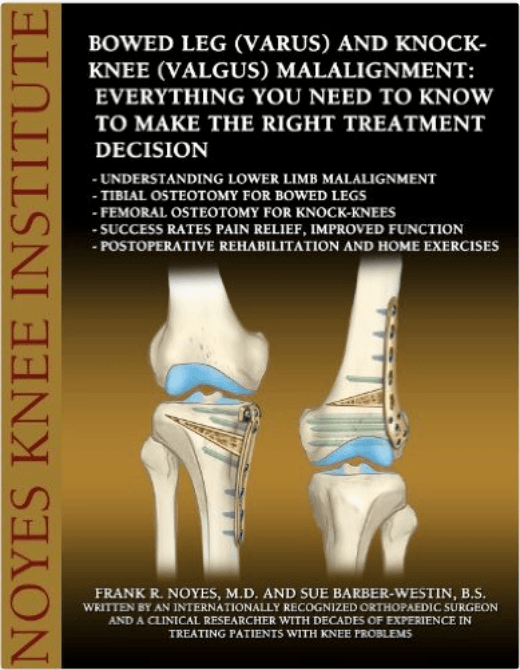Knee Surgery & Rehabilitation
Bowed legs may cause knee pain and limitations, especially as we grow older. The medical term used to describe this problem is varus and it indicates a malalignment of the lower extremity. Some people are born with bowed legs, but others may develop the problem in just one leg following an injury. The main problem with bowed legs is that osteoarthritis may develop in the inner (medial) area of the knee, causing pain, swelling, and limitations with recreational sports and eventually, problems with normal activities of daily living. This may be worsened with obesity or overuse of the knee joint, and can become a serious problem if the medial meniscus (cartilage) is removed.
Osteoarthritis may occur from bowed legs because there is an abnormal amount of stress and pressure placed on the inner portion of the knee joint. A good analogy to this problem is the wearing of a portion of a tire on a car that is out of proper alignment. If the alignment is not fixed, the tire will wear out on one side, shortening its expected lifespan.
Technically, the term osteoarthritis refers to damage to the articular cartilage in the joint. Articular cartilage is a protective layer of tissue located on the ends of bone that come together in the knee, which are the femur (thigh bone), tibial (shin bone), and patella (kneecap). There is a second type of cartilage in the knee called a meniscus. There are 2 menisci in the knee – a medial (inner) and a lateral (outer). Each meniscus is an important tissue that acts as a cushion between the femur and tibia.
Frequently Asked Questions
Bowed Legs What you need to know:
Overall, how advantageous is it to correct bowed legs?
We and many other orthopaedic centers believe it is very advantageous to have a HTO for a painful bowed leg. Several studies have shown that HTO buys many years before patients need further surgery such as a partial or total knee replacement. This is particularly helpful in younger patients who wish to remain active and avoid knee replacement for as long as possible. In addition, it is well known that bowed legs must be corrected in order for knee ligament surgery to be successful. Patients who require a meniscus transplant or articular cartilage restoration procedure need to have the bowed leg malalignment corrected or the procedure will most likely fail.
What are the overall success rates of HTO?
We have found that 70-80% of patients have a significant improvement in their symptoms and knee function. Many can return to recreational sports that allow an active lifestyle for many years after surgery. The majority can do their daily activities without problems. However, we always advise our patients that if there is already arthritis in knee joint that it will progress. About 20% of patients will not have a long-term benefit and may require a partial or total knee replacement.
Who are candidates for HTO?
- Patients aged less than 50 with bowed legs, medial side cartilage damage (not down to bone) with medial side pain with activity
- Patients with a bowed leg with an anterior cruciate and posterolateral ligament injury, before a ligament reconstruction
- Patients with a bowed leg before a meniscus transplant or articular cartilage procedure
Who are NOT candidates for HTO?
- Patients with bone exposed on the medial side (> 15 mm x 15 mm area)
- Patients who had a prior lateral meniscectomy or who have lateral cartilage damage
- Patients with significant lateral tibial subluxation
- Patients with painful patella arthrosis
- Patients in whom medial compartment depression and concavity prevent lateral compartment loading
- Patients with poor motivation or unrealistic expectations
- Patients who are obese
- Patients who had a prior joint infection
- Patients who have diabetes, rheumatoid arthritis, autoimmune diseases, malnutrition
- Patients who have no joint space left in the medial compartment
How soon will I start rehab?
In our clinic, patients begin rehabilitation the day after surgery. It is very important during the first week to control pain and swelling, which may be done with appropriate medications, ice, and elevation of the limb. It is also important to “turn on” the muscles in the leg which is done with the assistance of modalities (such as electrical muscle stimulation) guided by a physical therapist. The early start of knee motion and muscle strength exercises reduces the risk of complications such as excessive scarring and muscle atrophy. Our rehabilitation program lasts for 6 months, but most of the exercises may be done at home or in a fitness facility.
Click here to see our physical therapy program after HTO
What is rate of nonunion that requires subsequent surgery?
In our clinical studies, no further bone grafting or surgery for bone healing problems was required. We believe this was due to the type of fixation we used to stabilize the fracture site. We do inform patients that there is a 1-5% chance of a delayed union that requires the patient to spend a longer amount of time on crutches.
As a younger patient who needs a knee ligament reconstruction, why do I have to have a HTO first to realign my leg ?
The problem with performing any knee ligament reconstruction in a bowed leg is that there is a very high chance the new ligament graft will stretch out and fail. This happens because the bowed leg malalignment creates abnormally high forces on the lateral side of the knee. This means there is an abnormal amount of space between the femur and tibia with any weight-bearing activity and this joint opening places tremendous loads on the healing graft. The malalignment must be corrected and we usually prefer to do this first and then proceed with the ligament reconstruction a few months later, if it is still required.


